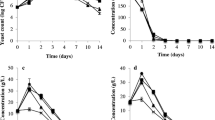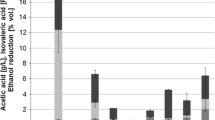Abstract
Herein, we report the influence of different combinations of initial concentration of acetic acid and ethanol on the removal of acetic acid from acidic wines by two commercial Saccharomyces cerevisiae strains S26 and S29. Both strains reduced the volatile acidity of an acidic wine (1.0 g l−1 acetic acid and 11% (v/v) ethanol) by 78% and 48%, respectively. Acetic acid removal by strains S26 and S29 was associated with a decrease in ethanol concentration of 0.7 and 1.2% (v/v), respectively. Strain S26 revealed better removal efficiency due to its higher tolerance to stress factors imposed by acidic wines. Sulfur dioxide (SO2) in the concentration range 95–170 mg l−1 inhibits the ability of both strains to reduce the volatile acidity of the acidic wine used under our experimental conditions. Therefore, deacidification should be carried out either in wines stabilized by filtration or in wines with SO2 concentrations up to 70 mg l−1. Deacidification of wines with the better performing strain S26 was associated with changes in the concentration of volatile compounds. The most pronounced increase was observed for isoamyl acetate (banana) and ethyl hexanoate (apple, pineapple), with an 18- and 25-fold increment, respectively, to values above the detection threshold. The acetaldehyde concentration of the deacidified wine was 2.3 times higher, and may have a detrimental effect on the wine aroma. Moreover, deacidification led to increased fatty acids concentration, but still within the range of values described for spontaneous fermentations, and with apparently no negative impact on the organoleptical properties.

Similar content being viewed by others
References
Albers E, Larsson C, Liden G, Niklasson C, Gustafsson L (1996) Influence of the nitrogen source on Saccharomyces cerevisiae anaerobic growth and product formation. Appl Environ Microbiol 62:3187–3195
Alexandre H, Nguyen Van Long T, Feuillat M, Charpentier C (1994) Contribution à l’étude des bourbes: influence sur la fermentescibilité des moûts. Rev Fr Oenol 146:11–20
Blateyron L, Sablayrolles JM (2001) Stuck and slow fermentations in enology: statistical study of causes and effectiveness of combined additions of oxygen and diammonium phosphate. J Biosci Bioeng 91(2):184–189
Boulton RB, Singleton VL, Bisson LF, Kunkee RE (1998) Yeasts and biochemistry of ethanol fermentation, principles and practices of winemaking, 1st edn. Springer, New York, pp 102–192
Carlton WK, Gump B, Fugelsang K, Hasson AS (2007) Monitoring acetaldehyde concentrations during micro-oxygenation of red wine by headspace solid-phase microextraction with on-fiber derivatization. J Agric Food Chem 55:5620–5625
Casal M, Cardoso H, Leão C (1996) Mechanisms regulating the transport of acetic acid in Saccharomyces cerevisiae. Microbiol 142(6):1385–1390
Casal M, Paiva S, Andrade RP, Gancedo C, Leão C (1999) The lactate proton symport of Saccharomyces cerevisiae is encoded by JEN1. J Bacteriol 181:2620–2623
Coote N, Kirsop HH (1974) The content of some organic acids in beer and other fermented media. J Inst Brew 80:474–483
Davis CR, Wibowo DJ, Lee TH, Fleet GH (1986) Growth and metabolism of lactic acid bacteria during and after malolactic fermentation of wines at different pH. Appl Environ Microbiol 51(3):539–545
Delfini C, Cocito C, Bonino M (1999) A review: Biochemical and molecular mechanisms in Saccharomyces cerevisiae that are involved in the formation of some volatile compounds in wines. J Int Sci Vigne Vin 33(4):195–211
Dos Santos MM, Gombert AK, Christensen B, Olsson L, Nielsen J (2003) Identification of in vivo enzyme activities in the cometabolism of glucose and acetate by Saccharomyces cerevisiae by using 13C-labeled substrates. Eukaryot Cell 2(3):599–608
Du Toit WJ, Lambrechts MG (2002) The enumeration and identification of acetic acid bacteria from South African red wine fermentations. Int J Food Microbiol 74(1–2):57–64
Edwards CG, Reynolds AF, Rodriguez AV, Semon MJ, Mills JM (1999) Implication of acetic acid in the induction of slow/stuck grape juice fermentations and inhibition of yeast by Lactobacillus sp. Am J Enol Vitic 50(2):204–210
Eglinton JM, Henschke PA (1999) Restarting incomplete fermentations: the effect of high concentrations of acetic acid. Aust J Grape Wine Res 52:71–78
Eglinton JM, Heinrich AJ, Pollnitz AP, Langridge P, Henschke PA, Lopes MB (2002) Decreasing acetic acid accumulation by a glycerol overproducing strain of Saccharomyces cerevisiae by deleting the ALD6 aldehyde dehydrogenase gene. Yeast 19(4):295–301
Erasmus DJ, Cliff M, van Vuuren HJJ (2004) Impact of yeast strain on the production of acetic acid, glycerol, and the sensory attributes of icewine. Am J Enol Vitic 55(4):371–378
Escudero A, Gogorza B, Melús MA, Ortín N, Cacho J, Ferreira V (2004) Characterization of the aroma of a wine from Maccabeo. Key role played by compounds with low odor activity values. J Agric Food Chem 52:3516–3524
Etievant PX (1991) Wine. In: Maarse H (ed) Volatile compounds in foods and beverages. 2nd edn. Marcel Dekker, New York, pp 483–546
Ferreira V, Lopez R, Cacho JF (2000) Quantitative determination of the odorants of young red wines from different grape varieties. J Sci Food Agric 80(11):1659–1667
Frivik S, Ebeler S (2003) Influence of sulfur dioxide on the formation of aldehydes in white wine. Am J Enol Vitic 54(1):31–38
Giudici P, Zambonelli C, Passarelli P, Castellari L (1995) Improvement of wine composition with cryotolerant Saccharomyces strains. Am J Enol Vitic 46(1):143–147
Guth H (1997) Identification of character impact odorants of different white wine varieties. J Agric Food Chem 45:3027–3032
Henschke P (1997) Wine yeast. In: Zimmerman FK, Entian KD (eds) Yeast sugar metabolism, biochemistry, genetics, biotechnology and applications. Technomic, Lancaster, pp 527–560
Lafon-Lafourcade S, Ribéreau-Gayon P (1977) Origines de l’acidité volatile des grands vins liquoreux. C R Acad Agric Fr 9:551–557
Lambrechts MG, Pretorius IS (2000) Yeast and its importance to wine aroma—a review. S Afr J Enol Vitic 21(Special Issue):97–129
Liu SQ, Pilone GJ (2000) An overview of formation and roles of acetaldehyde in winemaking with emphasis on microbiological implications. Int J Food Sci Technol 35:49–61
Lonvaud-Funel A (1999) Lactic acid bacteria in the quality improvement and depreciation of wine. Antonie Van Leeuwenhoek 76:317–331
Mason AB, Dufour J (2000) Alcohol acetyltransferases and the significance of ester synthesis in yeast. Yeast 16:1287–1298
Mateo JJ, Jiménez M (2000) Monoterpenes in grape juice and wines. J Chromatogr A 881:557–567
Mckay AM (1993) Microbial carboxylic ester hydrolases (EC 3.1.1) in food biotechnology—a review. Lett Appl Microbiol 16:1–6
McLafferty FW, Stauffer DB (1989) Registry of mass spectral data. In: John Wiley & Sons (ed) The Wiley/NBS registry of mass spectral data, New York
Mendes-Ferreira A, Mendes-Faia A, Leão C (2004) Growth and fermentation patterns of Saccharomyces cerevisiae under different ammonium concentrations and its implications in winemaking industry. J Appl Microbiol 97(3):540–545
Mendes-Ferreira A, Barbosa C, Falco V, Leão C, Mendes-Faia A (2009) The production of hydrogen sulphide and other aroma compounds by wine strains of Saccharomyces cerevisiae in synthetic media with different nitrogen concentrations. J Ind Microbiol Biotech 36:571–583
Molina AM, Swiegers JH, Varela C, Pretorius IS, Agosin E (2007) Influence of wine fermentation temperature on the synthesis of yeast-derived volatile aroma compounds. Appl Microbiol Biotechnol 77:675–687
Mollapour M, Piper P (2007) Hog1 mitogen-activated protein kinase phosphorylation targets the yeast Fps1 aquaglyceroporin for endocytosis, thereby rendering cells resistant to acetic acid. Mol cell Biol 27:6446–6456
Monk PR, Cowley PJ (1984) Effect of nicotinic acid and sugar concentration of grape juice and temperature on accumulation of acetic acid yeast fermentation. J Ferment Technol 62:515–521
Moruno EG, Delfini C, Pessione E, Giunta C (1993) Factors affecting acetic acid production by yeasts in strongly clarified grape musts. Microbios 74(301):249–256
Nurgel C, Erten H, Canbas A, Cabaroglu T, Selli S (2002) Influence of Saccharomyces cerevisiae strains on fermentation and flavor compounds of white wines made from cv. Emir grown in Central Anatolia. J Ind Microbiol Biotechnol 29(1):28–33
Office International de la Vigne et du Vin (2009) International code of oenological practices. OIV, Paris, p 259 p
Ong PKC, Acree TE (1999) Similarities in the aroma chemistry of Gewürztraminer variety wines and lychee (Litchi chinesis Sonn.) fruit. J Agric Food Chem 47:665–670
Paiva S, Althoff S, Casal M, Leão C (1999) Transport of acetate in mutants of Saccharomyces cerevisiae defective in monocarboxylate permeases. FEMS Microbiol Lett 170(2):301–306
Pampulha ME, Loureiro V (1989) Interaction of the effects of acetic acid and ethanol on inhibition of fermentation in Saccharomyces cerevisiae. Biotechnol Lett 2(4):269–274
Patel S, Shibamoto S (2002) Effect of different strains of Saccharomyces cerevisiae on production of volatiles in Napa gamay wine and petite syrah wine. J Agric Food Chem 50:5649–5653
Peinado RA, Moreno J, Bueno JE, Moreno JA, Mauricio JC (2004) Comparative study of aromatic compounds in two young white wines subjected to pre-fermentative cryomaceration. Food Chem 84:585–590
Perez L, Valcarcel MJ, Gonzalez P, Domecq B (1991) Influence of Botrytis infection of the grapes on the biological aging process of Fino Sherry. Am J Enol Vitic 42(1):58–62
Pinto I, Cardoso H, Leão C, van Uden N (1989) High enthalpy and low enthalpy death in Saccharomyces cerevisiae induced by acetic acid. Biotechnol Bioeng 33(10):1350–1352
Pizarro F, Vargas FA, Agosin E (2007) A systems biology perspective of wine fermentations. Yeast 24(11):977–991
Radler F (1993) Yeast metabolism of organic acids. In: Gram H (ed) Wine microbiology and biotechnology. Harwood, Chur, pp 165–182
Rasmussen JE, Schultz E, Snyder RE, Jones RS, Smith CR (1995) Acetic acid as a causative agent in producing stuck fermentations. Am J Enol Vitic 46:278–280
Ribéreau-Gayon P, Lafon-Lafourcade S, Dubourdieu D, Lucmaret V, Larue F (1979) Métabolisme de Saccharomyces cerevisiae dans le moût de raisins parasités par Botrytis cinerea. C R Acad Sci Fr 289:441–444
Ribéreau-Gayon P, Glories Y, Maujean A, Dubourdieu D (2000) The chemistry of wine and stabilization and treatments. Handbook of enology, vol. 2, 1st edn. Wiley, Chichester
Rizzon LA, Miele A (2004) Avaliação da cv. Tannat para elaboração de vinho tinto. Ciênc Tecnol Aliment 24(2):223–229
Romano P, Suzzi G (1992) Wine microbiology and biotechnology. Harwood, Chur
Romano P, Suzzi G, Turbanti L, Polsinelli M (1994) Acetaldehyde production in Saccharomyces cerevisiae wine yeasts. FEMS Microbiol Lett 118(3):213–218
Romano P, Suzzi G, Domizio P, Fatichenti F (1997) Secondary products formation as a tool for discriminating non-Saccharomyces wine strains. Strain diversity in non-Saccharomyces wine yeasts. Antonie van Leeuwenhoek 71:239–242
Saerens SM, Verstrepen KJ, Van Laere SDM, Voet AR, Van Dijck P, Delvaux FR, Thevelein JM (2006) The Saccharomyces cerevisiae EHT1 and EEB1 genes encode novel enzymes with medium-chain fatty acid ethyl ester synthesis and hydrolysis capacity. J Biol Chem 281(7):4446–4456
Schüller HJ (2003) Transcriptional control of nonfermentative metabolism in the yeast Saccharomyces cerevisiae. Curr Genet 43(3):139–160
Thomas S, Davenport RR (1985) Zygosaccharomyces bailii, a profile of characteristics and spoilage activities. Food Microbiol 2:157–169
Viegas CA, Rosa MF, Sá-Correia I, Novais JM (1989) Inhibition of yeast growth by octanoic and decanoic acids produced during ethanolic fermentation. Appl Environ Microbiol 55(1):21–28
Vilela-Moura A, Schuller D, Mendes-Faia A, Côrte-Real M (2008) Reduction of volatile acidity of wines by selected yeast strains. Appl Microbiol Biotechnol 80(5):881–890
Wondra M, Boveric M (2001) Analyses of aroma components of Chardonnay wine fermented by different yeast strains. Food Technol Biotechnol 39(2):141–148
Acknowledgments
This work was funded by Institute for Biotechnology and Bioengineering, Centre of Genetics and Biotechnology (IBB/CGB-UTAD) and by the projects PTDC/AGRALI/71460/2006, POCI/AGR/56102/2004 and PTDC/AGR-ALI/103392/2008 from the Portuguese Research Agency (Fundação para a Ciência e Tecnologia). The research leading to these results has also received funding from the European Community's Seventh Framework Programme (FP7/2007-2013) under grant agreement no. 232454. The authors thank Paula Ribeiro for SPME extractions and Virgílio Falco for support on GC-MS analysis of wines.
Author information
Authors and Affiliations
Corresponding author
Rights and permissions
About this article
Cite this article
Vilela-Moura, A., Schuller, D., Mendes-Faia, A. et al. Effects of acetic acid, ethanol, and SO2 on the removal of volatile acidity from acidic wines by two Saccharomyces cerevisiae commercial strains. Appl Microbiol Biotechnol 87, 1317–1326 (2010). https://doi.org/10.1007/s00253-010-2558-7
Received:
Revised:
Accepted:
Published:
Issue Date:
DOI: https://doi.org/10.1007/s00253-010-2558-7




